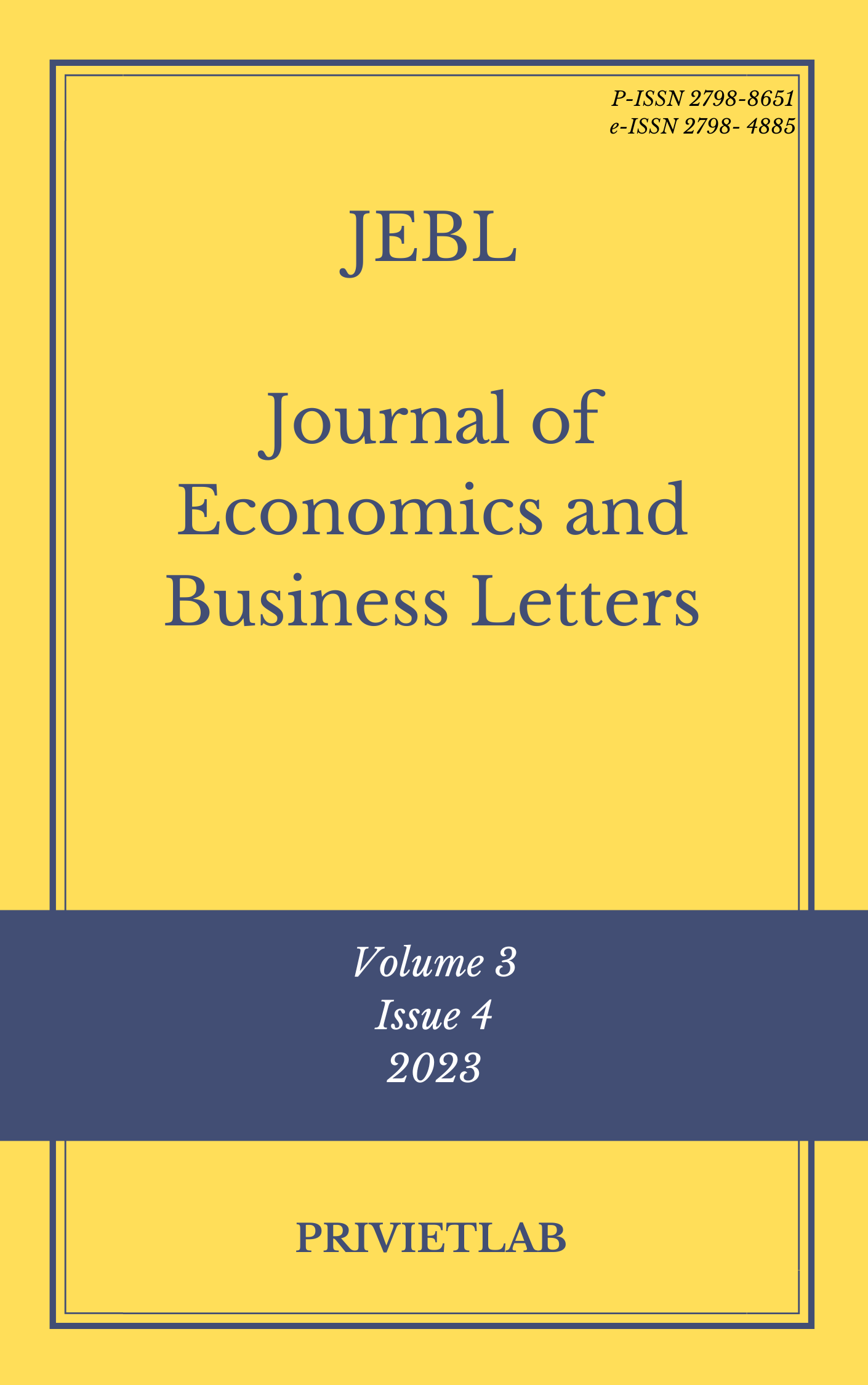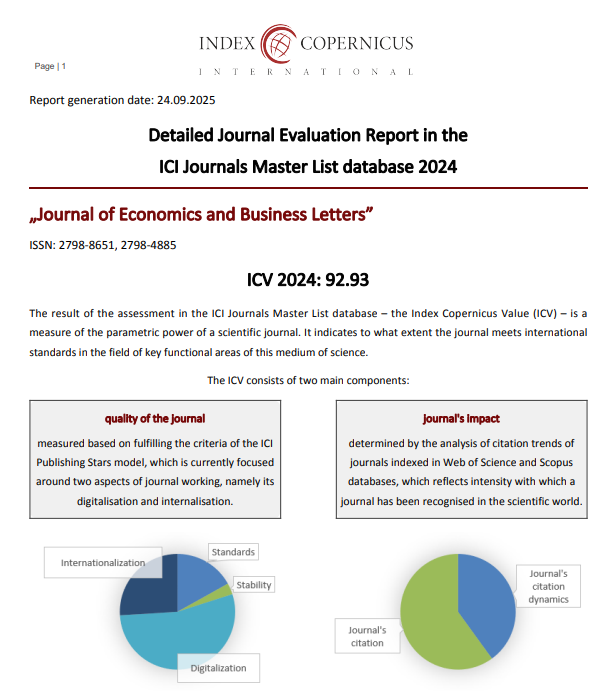Cognitive reflection and the disposition effect
a lab experiment
DOI:
https://doi.org/10.55942/jebl.v3i4.204Keywords:
disposition effect, cognitive reflection test, behavioral biases, lab experimentAbstract
This research investigates the connection between cognitive reflection and the disposition effect, a well-known bias in the behavioral finance literature. Utilizing the Cognitive Reflection Test (CRT) developed by Frederick (2005), we measured cognitive abilities in a laboratory-based experiment comprising 55 students. The main goal was to investigate the extent to which these cognitive resources might modulate the disposition effect. The study was conceptualized within the framework of the dichotomy between a deliberative long-term self and an impulsive short-term self, as detailed in Kahneman's 2011 two-systems theory. The findings indicate a significant negative correlation between cognitive abilities and the disposition effect, providing extra empirical support for Kahneman's theory. This study presents new empirical evidence of the association between cognitive reflection and behavioral biases associated with decision-making under conditions of risky, thus providing a basis for possible interventions to mitigate these biases. The implications of this study are not limited to academia, but may provide information for the development of future financial education programs to enhance the decision-making process of individuals, whether in public or private companies.
References
Baron, J., Scott, S., Fincher, K., and Metz, S. (2015) “Why does the cognitive reflection test (sometimes) predict utilitarian moral judgment (and other things)?” Journal of Applied Research in Memory and Cognition 4 (3), 265-284.
Benjamin, D., Brown, S., and Shapiro, J. (2013) “Who is ‘behavioral’? Cognitive ability and anomalous preferences.” Journal of the European Economic Association 11 (6), 1231-1255.
Blaywais, R., and Rosenboim, M. (2019) “The effect of cognitive load on economic decisions.” Managerial and Decision Economics 40 (8), 993-999.
Brañas-Garza, P., Kujal, P., and Lenkei, B. (2019) “Cognitive Reflection Test: Whom, how, when.” Journal of Behavioral and Experimental Economics 82 (10), 14-55.
Busenitz, L., and Barney, J. (1997) “Differences between entrepreneurs and managers in large organizations: Biases and heuristics in strategic decision-making.” Journal of Business Venturing 12 (1), 9-30.
Chiu, S., Chen, H., Yeh, Y., and Shu, P. (2004) “Does year end sweep ameliorate the disposition effect of mutual fund investors?” Working Paper, National Taiwan University.
Coval, J., and Shumway, T. (2005) “Do behavioral biases affect prices?” Journal of Finance 60 (1), 1-34.
Dhar, R., and Zhu, N. (2006) “Up close and personal: investor sophistication and the disposition effect.” Management Science 52, 726–740.
Da Costa Jr., N., Goulart, M., Cupertino, C., Macedo Jr., J., and Da Silva, S. (2013) “The disposition effect and investor experience.” Journal of Banking & Finance 37, 1669–1675.
Deck, C., and Jahedi, S. (2015) “The effect of cognitive load on economic decision making: A survey and new experiments” European Economic Review 78, 97-119.
Epstein, S. (1994) “Integration of the cognitive and the psychodynamic unconscious.” American Psychologist 49 (8), 709-724.
Evans, J. (2003) “In two minds: Dual-process accounts of reasoning.” Trends in Cognitive Sciences 7 (10), 454-459.
Frederick S. (2005) “Cognitive reflection and decision making.” Journal of Economic Perspectives 19 (4), 25–42.
Fischbacher, U., Hoffmann, G., and Schudy, S. (2017) “The causal effect of stop-loss and take-gain orders on the disposition effect.” Review of Financial Studies 30 (6), 2110–2129.
Genovese, D., and Myer, C. (2001) “Loss aversion and seller behavior: Evidence from the housing market.” Quarterly Journal of Economics 116 (4), 1233-1260.
Goulart, M., Da Costa Jr., N., Santos, A., Takase, E., and Da Silva, S. (2013) “Psychophysiological correlates of the disposition effect.” Plos One 8, e54542.
Heath, C., Huddart, S., and Lang, M. (1999) “Psychological factors and stock option exercise.” Quarterly Journal of Economics 114 (2), 601-627.
Janssen, E., Raoelison, M., and De Neys, W. (2020) ““You're wrong!”: The impact of accuracy feedback on the bat-and-ball problem.” Acta Psychologica 206, e103042.
Kahneman, D. (2011) Thinking, Fast and Slow. Farrar, Straus and Giroux.
Kahneman, D., and Frederick, S. (2002) “Representativeness revisited: Attribute substitution in intuitive judgment.” In Heuristics and biases: The psychology of intuitive judgment, 49–81.
Locke, P., and Mann, S. (2005) “Professional trader discipline and trade disposition.” Journal of Financial Economics 76, 401–444.
Maloney, E. A.; Retanal, F. (2020). “Higher math anxious people have a lower need for cognition and are less reflective in their thinking.” Acta Psychologica, 202, 102939.
Noori, M. (2016) “Cognitive reflection as a predictor of susceptibility to behavioral anomalies.” Judgment and Decision Making 11 (1), 114–120.
Odean, T. (1998) “Are investors reluctant to realize their losses?” Journal of Finance 53 (5), 1775-1798.
Oechssler, J., Andreas, R., and Schmitz, P. (2009) “Cognitive abilities and behavioral biases.” Journal of Economic Behavior & Organization 72 (1), 147-152.
Prates, W., Da Costa Jr., N., and Santos, A. (2019) “Efeito disposição: Propensão à venda de investidores individuais e institucionais. (The disposition effect: Propensity to sell of individual and institutional investors.)” Revista Brasileira de Economia 73 (1), 97-119.
Primi, C., Morsanyi, K., Chiesi, F., Donati, M. A., and Hamilton, J. (2016). “The development and testing of a new version of the cognitive reflection test applying item response theory (IRT)”. Journal of Behavioral Decision Making, 29, 453–469.
Richards, D., Fenton-O’Creevy, M., Rutterford, J., and Kodwani, D. (2018) “Is the disposition effect related to investors’ reliance on System 1 and System 2 processes or their strategy of emotion regulation?” Journal of Economic Psychology 66, 79-92.
Shefrin, H., and Statman, M. (1985) “The disposition to sell winners too early and ride losers too long: theory and evidence.” Journal of Finance 40 (3), 777-790.
Sirota, M., Dewberry, C., Juanchich, M., Valuš, L., and Marshall, A.C. (2021) “Measuring cognitive reflection without maths: Development and validation of the verbal cognitive reflection test”. Journal of Behavioral Decision Making, 34, 322–343.
Stanovich, K., and West, R. (2000) “Individual differences in reasoning: Implications for the rationality debate?” Behavioral and Brain Sciences 23 (5), 645-665.
Fischbacher, U., Hoffmann, G., and Schudy, S. (2017) “The causal effect of stop-loss and take-gain orders on the disposition effect.” Review of Financial Studies 30 (6), 2110–2129.
Toplak, M.E., West, R.F., and Stanovich, K.E. (2014). “Assessing miserly information processing: An expansion of the cognitive reflection test”.Thinking & Reasoning, 20, 147–168.
Weber, M., and Camerer, C. (1998) “The disposition effect in securities trading: An experimental analysis.” Journal of Economic Behavior & Organization, 33 (2), 167-184.
Downloads
Published
How to Cite
Issue
Section
License
Copyright (c) 2023 Journal of Economics and Business Letters

This work is licensed under a Creative Commons Attribution 4.0 International License.
















